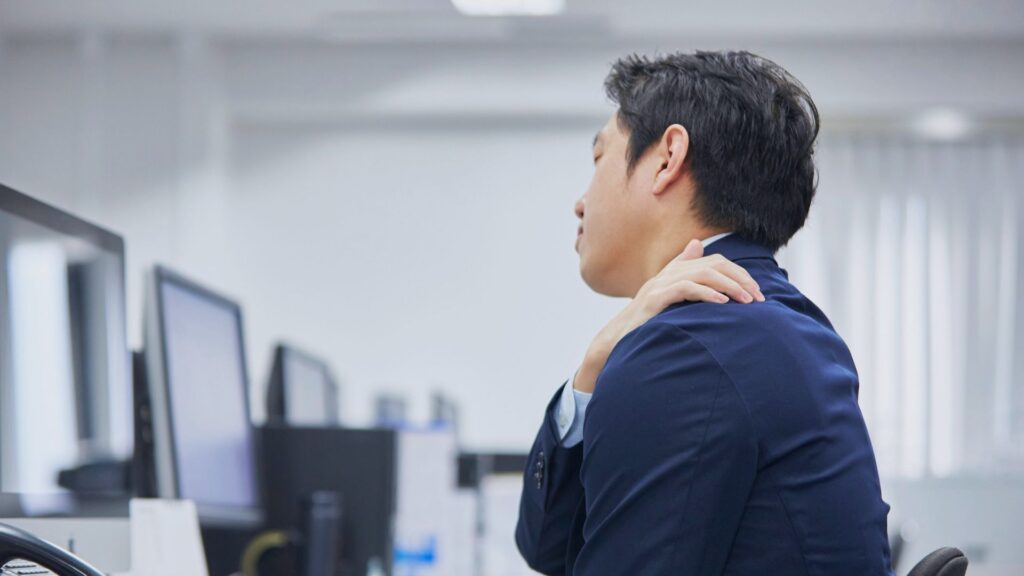Text Neck: Causes, Symptoms, and Posture Tips for a Healthier Spine
Do you ever find yourself scrolling through your phone for long periods, head tilted forward, shoulders slouched, and neck aching afterwards? You’re not alone. In our increasingly digital world, text neck has become a common and growing cause of neck pain, stiffness, and posture problems among adults and even teenagers.
At London Spine Health, we regularly see patients with neck and upper back pain caused by prolonged screen time and poor posture. The good news is that text neck is preventable and often reversible with the right awareness, habits, and posture techniques.

What Is Text Neck?
Text neck refers to the strain and pain in the neck and shoulders caused by repeatedly looking down at phones, tablets, or laptops. When you tilt your head forward, the pressure on your cervical spine increases dramatically.
To put this into perspective:
- At a neutral position (head upright), your head exerts around 5 kg of force on the neck.
- At a 60° forward tilt — the typical “phone-checking” angle — this pressure can increase to 25 kg.
Over time, this forward head posture leads to muscle fatigue, spinal misalignment, and even degenerative changes in the neck if not corrected.
Common Symptoms of Text Neck
You might be experiencing text neck if you notice:
- Persistent neck, shoulder, or upper back pain
- Headaches that worsen after screen time
- Tightness or stiffness in the neck muscles
- Reduced range of motion when turning your head
- Tingling or numbness in the arms (in severe cases)
These symptoms are often mistaken for general tension or stress, but the underlying cause is frequently poor posture during screen use.
How to Prevent and Relieve Text Neck
The key to managing and preventing text neck lies in small, consistent changes in posture, screen habits, and muscle strengthening. Here are expert-backed tips from our spine specialists in London:
1. Keep Your Screen at Eye Level
Whether using a phone, tablet, or computer, keep your screen at eye height to avoid bending your neck forward.
- Use a phone stand or adjustable desk mount for prolonged use.
- When reading or typing, hold your device higher rather than dropping your chin.
This one simple habit can reduce up to 60% of the strain on your neck muscles.
2. Take Frequent Breaks
Follow the 20-20-20 rule: every 20 minutes, look 20 feet away for 20 seconds.
- Stand up, stretch, and move your neck gently.
- Rolling your shoulders or doing neck circles can help release built-up tension.
Short breaks help prevent muscle fatigue and stiffness, especially during long work or study sessions.
3. Strengthen Your Neck and Shoulder Muscles
Weak neck and upper back muscles make it harder to maintain good posture. Add these exercises to your daily routine:
- Chin tucks: Gently pull your chin back as if making a “double chin.” Hold for 5 seconds.
- Scapular squeezes: Pinch your shoulder blades together and hold.
- Neck extensions: Slowly tilt your head back to stretch the front of your neck.
Strong muscles support your spine and keep your posture upright naturally.
4. Adjust Your Workspace Ergonomics
If you work on a laptop or desktop, ensure:
- The top of your screen is at or slightly below eye level.
- Your shoulders are relaxed, and elbows are close to your body.
- You sit with both feet flat on the floor and back supported.
Using an ergonomic chair or standing desk can significantly reduce the risk of text neck and related spinal problems.
5. Stay Active and Stretch Regularly
Regular exercise improves posture, flexibility, and blood flow to your neck and back muscles.
Try:
- Yoga or Pilates for posture and core strength
- Swimming for overall spinal health
- Gentle stretching throughout the day, especially if you work at a desk
Movement keeps your spine healthy and helps reverse the stiffness caused by prolonged sitting.
When to See a Spine Specialist
If your neck pain persists for more than a few weeks or is accompanied by numbness, tingling, or weakness, it’s important to consult a spine specialist. Persistent text neck can lead to disc degeneration, nerve compression, and chronic posture issues if left untreated.
At London Spine Health, our team offers expert diagnosis, advanced imaging, and personalised treatment plans from physiotherapy and posture correction to minimally invasive spine procedures when necessary.
Key Takeaway
Modern life may be digital, but your spine still needs analogue care. By being mindful of your posture, taking regular breaks, and strengthening your neck muscles, you can prevent text neck and protect your long-term spinal health.
If you’re struggling with neck or back pain and suspect it may be due to posture or screen use, contact London Spine Health today. Our experienced spine specialists in London are here to help you restore balance, mobility, and comfort.
FAQs About Text Neck
- What is the fastest way to fix text neck?
Improving posture, taking regular screen breaks, and strengthening your neck and shoulder muscles can relieve text neck symptoms within weeks. - Can text neck cause permanent damage?
If ignored, long-term poor posture can cause spinal degeneration, disc issues, and chronic pain but early intervention can prevent permanent damage. - Should I see a doctor for text neck pain?
Yes. If your pain is persistent or radiates into your arms or shoulders, consult a spine specialist in London for a proper diagnosis and treatment plan.
Frequently Asked Questions
Can a herniated disc heal on its own?
Yes, many mild cases improve within weeks through conservative care such as rest, physiotherapy, and medication.
How do I know if my back pain is serious?
If pain is persistent, severe, or accompanied by numbness, weakness, or bladder/bowel issues, seek medical advice immediately.
Is surgery always necessary for a slipped disc?
No. Most patients improve with physiotherapy, medications, or spinal injections. Surgery is only required for severe or unresponsive cases.
How long does recovery take after treatment?
Recovery depends on the treatment. Many patients return to normal activities within weeks after minimally invasive surgery.
